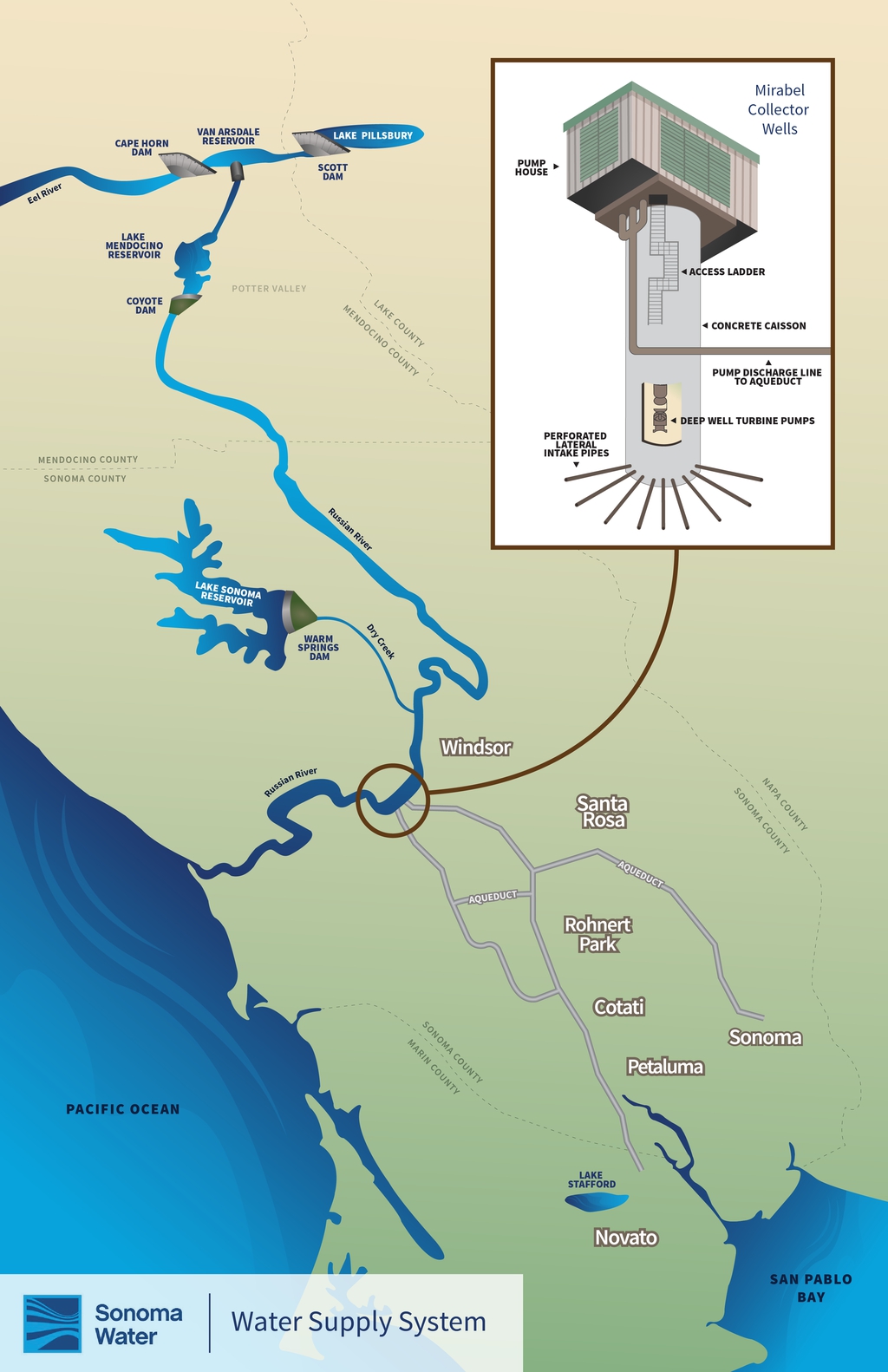View 2025 Rainfall and Reservoirs: Water Year Wrap-Up webinar
Sonoma Water provides high-quality drinking water to over 600,000 people in Sonoma and northern Marin counties.
- View the current water storage levels
- View the Water Supply Roadmap
- Learn more about our water contractors
- Learn more about your water quality
- View Water Delivery Data
- Learn about our Water Supply Strategy Action Plan
- Atmospheric Rivers
- Advanced Quantitative Precipitation Information (AQPI)
- Blanket Waivers for Drinking Water Separation
Sonoma Water Water Shortage Assessment Report
Starting July 1, 2022, water suppliers in California are required (California Water Code §10632.1) to do an annual assessment of their water supply and demand. This assessment is called the Annual Water Supply and Demand Assessment (AWSDA). The AWSDA helps water suppliers assess how reliable their water supply will be for the current year and the following assumed-dry year. The AWSDA forecasts near-term water supply conditions to ensure shortage response actions are triggered in a timely manner. Every year, Sonoma Water evaluates water conditions from different sources and how much is needed for the current year assuming the next year is dry. This assessment includes details and numbers for each water source.
View the Sonoma Water Water Shortage Assessment Report
Russian River System

The Russian River originates in central Mendocino County, approximately 15 miles north of Ukiah. It drains 1,485 square miles including much of Sonoma and Mendocino counties, and reaches the Pacific Ocean at Jenner, 20 miles west of Santa Rosa. Its main channel is 110 miles long and flows generally southward from its headwaters near Redwood and Potter Valleys, to Mirabel Park, where the direction of flow changes to generally westward as it crosses part of the Coast Range. There are five principal tributaries: the East Fork of the Russian River, Big Sulphur Creek, Mark West Creek, Maacama Creek and Dry Creek.
There are two major reservoir projects that provide water supply for the Russian River watershed: Lake Mendocino on the East Fork of the Russian River and Lake Sonoma on Dry Creek. Lake Mendocino and Lake Sonoma are dual-purpose reservoirs in that they provide flood protection (managed by the U.S. Army Corps of Engineers) and water supply storage (releases managed by Sonoma Water). Sonoma Water, as local sponsor, controls and coordinates water supply releases from Lake Mendocino and Lake Sonoma in accordance with its water rights permits and the requirements of State Water Resources Control Board’s Decision 1610. Decision 1610 establishes minimum instream flow requirements for the mainstem Russian River and Dry Creek. Sonoma Water makes releases to meet downstream demands from agricultural, commercial, and residential individual water uses and other public water systems and to maintain minimum instream flow requirements for beneficial uses, including recreation and fish habitat.
The Potter Valley Project, owned and operated by Pacific Gas and Electric, is a hydroelectric project that provides an interbasin water transfer to the East Fork of the Russian River. Its operations are not coordinated with the operation of Coyote Valley Dam at Lake Mendocino. PG&E releases water from Lake Pillsbury to meet minimum instream flow requirements on the Eel River and to divert water through the Potter Valley Project to generate electricity and maintain minimum instream flow requirements in the East Fork Russian River. The water diverted through the Potter Valley Project flows into the East Fork of the Russian River. The Potter Valley Irrigation District diverts a portion of the released water for irrigation, with the remaining eventually flowing to Lake Mendocino.
Coyote Valley Dam and Lake Mendocino
Located on the East Fork of the Russian River, Coyote Dam is a rolled earth embankment dam that forms Lake Mendocino. Lake Mendocino is a U.S. Army Corps of Engineers project that began storing water in 1959. It captures a drainage area of about 105 square miles, and provides a total storage capacity of 118,000 acre-feet with a water supply pool of 70,000 acre-feet.
Warm Springs Dam and Lake Sonoma
Located about 14 miles northwest of Healdsburg, Warm Springs Dam is a rolled earth embankment dam that forms Lake Sonoma. Sonoma Water generates electricity at Warm Springs Dam through a hydroelectric turbine. Located at the confluence of Warm Springs Creek and Dry Creek, this lake began storing water in 1984 and has a total storage capacity of 381,000 acre-feet with a water supply pool of 245,000 acre-feet.
Warm Springs Dam is a multi-purpose reservoir that serves as a flood control, water supply and recreational facility. Sonoma Water is the local cost-sharing partner for Warm Springs Dam, and determines the amount of water to be released when the lake level is in the water supply pool, and the U.S. Army Corps of Engineers manages flood control releases.
Visit the Army Corps of Engineers Warm Springs Dam & Lake Sonoma Project Site
River Management System
 Mirabel & Wohler Collectors
Mirabel & Wohler Collectors
Sonoma Water has constructed six collector wells adjacent to the Russian River. Collectors 1 and 2 were constructed in the late 1950s and are located near the Wohler Bridge. Collectors 3, 4 and 5 were constructed between 1975 and 1985 and are located near Mirabel Park. Construction of Sonoma Water's newest collector well, Collector 6, was completed in the spring of 2006. Groundwater is extracted by each collector well from the alluvial aquifer adjacent to and beneath the Russian River.
A typical collector well has a 13-foot to 18-foot diameter concrete caisson (pipe) extending approximately 80 feet below the surface of the natural streambed. Six to 12 horizontal intake laterals (perforated pipes) ranging from 8-inch to 18-inch in diameter extend radially from the bottom of each caisson into the aquifer. Each collector well houses two large vertical turbine pumps equipped with electric motors that range from 1,000 to 2,000 horsepower.
Mirabel Inflatable Dam
Sonoma Water operates an inflatable dam on the Russian River in the Mirabel area to increase production capacity during peak demand months. Operation of the inflatable dam increases production capacity in two important ways. First, surface water immediately behind the dam can be diverted to a series of infiltration ponds that are constructed adjacent to the three Mirabel collector wells. Fish screening facilities ensure the safety of the fish in the river. Second, infiltration to the underlying aquifer behind the dam is significantly improved by increasing the recharge area from the river. Permanent fish ladders provide fish passage when the dam is raised.
Well Field
As a stand-by water source, seven vertical wells were constructed in the late 1990s near the Mirabel collectors, providing 7 to 10 million gallons per day (mgd) of back up capacity.
Chlorination Facilities
The naturally filtered water entering the collector wells is extremely clean and requires no additional treatment+; however, chlorine is added as a precaution against possible contamination in the distribution system.
pH Adjustment/Corrosion Control System
The Russian River water has a natural pH of about 7.1 - 7.6. To reduce corrosion of lead and copper present in indoor plumbing fixtures, it is desirable to raise the pH of the river water to 8.3 - 8.5. Sonoma Water operates pH Adjustment/Corrosion Control facilities, located at the Wohler pumping plant and at the chlorination facility, where sodium hydroxide is added to the water supply. This treatment helps reduce dissolved metal content entering the wastewater treatment plants in areas served by Sonoma Water.
Water Supply Wells
Santa Rosa Plain Wells: Sonoma Water operates three groundwater wells in the Santa Rosa Plain. These wells pump groundwater from several hundred feet below the ground surface and are capable of providing up to 7 million gallons per day. The wells were originally constructed in 1977 in response to drought conditions. Two of the wells were replaced in the late 1990s.
Aqueduct Transmission System
The aqueduct system consists of storage tanks, pipelines and booster (pump) stations and is designed to carry the anticipated (average) daily demand during peak demand. Maximum demand usually occurs during July or August.
Tanks: Eighteen steel water storage tanks placed throughout the transmission system store about 129 million gallons.
Pipelines: Sonoma Water maintains over 88 miles of underground pipeline extending from the Russian River to the cities and water districts in our service area. The pipes range in size from 16 to 54 inches in diameter.
Santa Rosa Plain wells: Three wells are capable of providing about 4-6 million gallons per day, and were constructed in 1977 in response to drought conditions.
Booster stations: Seven booster stations are located in the water transmission system with pumps to maintain water flow and adequate pressure within the aqueducts.
Aqueduct Corrosion Protection Upgrade Project
Water Rights
As early as 1954, Sonoma Water applied to the State Water Resources Control Board, which has the authority over water rights, for rights to appropriate Russian River water. Riparian water rights entitle the owner of land containing or abutting a natural stream the right to use natural flows by direct diversions for beneficial purposes without a permit. If water is to be stored for use in another season, owners must obtain an appropriative water rights permit. As the local project sponsor for the construction of the Coyote Valley and Warm Springs dams, Sonoma Water retains rights to some of the water stored in these reservoirs and controls the releases from the reservoirs' water supply pools. Sonoma Water also has rights for direct diversion and rediversion of water at the Wohler and Mirabel collectors. Sonoma Water is required to maintain minimum streamflows, according to Decision 1610, at various points on the Russian River and Dry Creek in accordance with its water rights permits.
Supply Availability for Urban Water Suppliers
Sonoma Water is required to provide information on the volume of water they expect to deliver in each of the next three years using the assumptions in the May 2016 Emergency Regulation adopted by the State Water Resources Control Board. The May 2016 Emergency Regulation replaces the state-developed urban water conservation standards with locally-developed conservation standards based upon each agency’s specific circumstances. The regulation requires individual urban water suppliers to conduct a stress test and self-certify the level of available water supplies they have assuming three additional dry years, as well as the level of conservation necessary to assure adequate supply over that time. Urban water wholesalers are required to make projections about how much water they expect to deliver to retail water suppliers under the three-dry-years scenario, when the supply projection for the next three years is based on current supply conditions plus an assumed three-year hydrology mirroring the 2012-13, 2013-14, and 2014-15 water years.
Supply Availability for Urban Water Suppliers
Sonoma County Water Agency Watershed Sanitary Survey
A watershed sanitary survey focuses on the first barrier to contamination of the drinking water supply, namely source water protection. Evaluating source water quality and watershed contaminant sources provides key information to aid in understanding how to maintain and possibly improve the first barrier. This Fourth Update for the Sonoma County Water Agency (Water Agency) watershed sanitary survey covers the period January 1, 2018 through December 31, 2022. The key findings and conclusions for this report are organized as they pertain to water quality and watershed contaminant sources.
2023 Watershed Sanitary Survey
